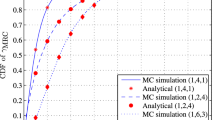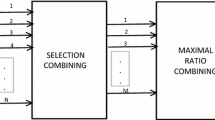Abstract
Performance of a coherent MQAM system in the presence of frequency-selective Rayleigh fading, co-channel interference (CCI) and additive white Gaussian noise (AWGN) is presented. Square-root raised-cosine filters are used in both the transmitter and receiver for an optimum performance in a band-limited AWGN channel. Frequency-selective Rayleigh fading channel is modeled as a two-ray model. Based on the characteristic functions of the received signals and a discrete Fourier transform (DFT) method, an analytical procedure to compute the error probability is derived. Numerical results for an illustrative example of a 16QAM system are given. Effects of CCI and frequency-selective fading on the system performance are examined. Accuracy of the proposed method is discussed in comparison with other simulation and analytical techniques.
Similar content being viewed by others
References
P.M. Fortune, L. Hanzo and R. Steele, Transmission of SBC speech via 16-level QAM over mobile radio channels, in: GLOBECOM '88 (1988) pp. 832–836.
E. Issman and W.T. Webb, Carrier recovery for 16-level QAM in mobile radio, in: IEE Colloquium in Multi-Level Modulation Techniques for Point-To-Point and Mobile Radio (March 1990).
W.T. Webb, L. Hanzo and R. Steele, Bandwidth-efficient QAM schemes for Rayleigh fading channels, IEE Proceedings, Part I, 138(3) (June 1991) 169–175.
W.T. Webb and R. Steele, Equalizer techniques for QAM transmissions over dispersive mobile radio channels, IEE Proceedings, Part I, 138(6) (December 1991) 566–576.
C. Liu and K. Feher, Bit error rate performance of π/4-DQPSK in a frequency selective fast Rayleigh fading channel, IEEE Trans. Veh. Tech. 40(3) (August 1991) 558–568.
I. Korn, Differential phase shift keying in two-path Rayleigh channel with ACI, IEEE Trans. Veh. Tech. 40(2) (May 1991) 461–471.
O. Andrisano and A. Barigazzi, Interference effects in high spectrum efficiency MQAM radio systems, IEE Proceedings, Part I, 137(4) (August 1991) 213–220.
V.K. Prabhu, Some considerations of error bounds in digital systems, Bell Systems Technical Journal (1971) 3127–3151.
E.Y. Ho and Y.S. Yeh, A new approach for evaluating the error probability in the presence of ISI and additive noise, Bell Systems Technical Journal 49(9) (1970) 2249–2265.
O. Shimbo and M.I. Celebiler, The probability of error due to ISI and Gaussian noise in digital communication systems, IEEE Trans. Commun. COM-19 (1971) 113–120.
O. Shimbo, R.J. Fang and M.I. Celebiler, Performance of M-ary PSK systems in Gaussian noise and ISI, IEEE Trans. Inform. Theory IT-19 (1973) 44–58.
A.J. Levy, Fast error evaluation in the presence of intersymbol interference, IEEE Trans. Commun. 33(5) (May 1985) 479–481.
A. Papoulis, Probability, Random Variables, and Stochastic Processes (McGraw-Hill, 1984).
R. Maciejko, Digital modulation in Rayleigh fading in the presence of CCI and noise, IEEE Trans. Commun. 29(9) (September 1981) 1379–1387.
Author information
Authors and Affiliations
Rights and permissions
About this article
Cite this article
Xiang, Z., Le‐Ngoc, T. & Bi, G. Performance of coherent MQAM schemes in the presence of frequency‐selective Rayleigh fading and CCI. Mobile Networks and Applications 5, 73–84 (2004). https://doi.org/10.1023/A:1019183806857
Issue Date:
DOI: https://doi.org/10.1023/A:1019183806857




